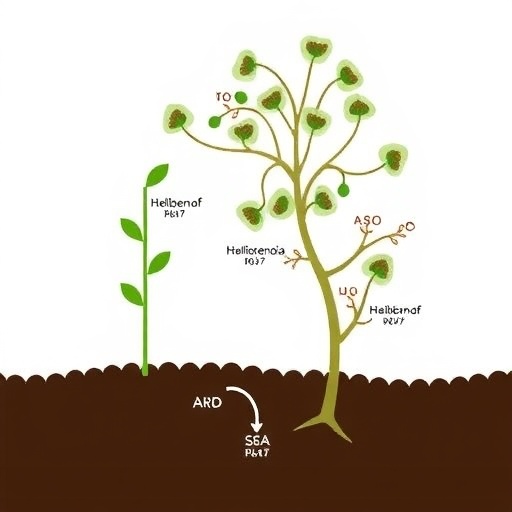Researchers have recently unveiled groundbreaking insights into the complex relationship between soybean plants and rhizobia, a soil bacterium crucial for nitrogen fixation. This study, conducted by a team led by Gao Jh., Tang F., and Wang Yw., investigates the intricate immune responses of soybeans mediated by the Rj4 genetic locus. They employed a combination of proteomic and transcriptomic analyses to decode the immune pathways and their subsequent impact on symbiotic interactions with rhizobia. The findings reveal that the Rj4 locus plays a pivotal role in regulating the plant’s immunity network, ultimately influencing the efficiency of symbiotic nitrogen fixation, a vital process for sustainable agriculture.
The research highlights the importance of understanding plant-microbe interactions, especially in the context of global agricultural demands. Soybean is a major crop, providing essential proteins and oils to human diets while contributing significantly to soil health through its ability to fix atmospheric nitrogen. The study’s findings offer a comprehensive view of how soybean plants can enhance their defense mechanisms against potential bio-aggressors while simultaneously managing beneficial relationships with rhizobia, a duality crucial for crop yield and sustainability.
By integrating extensive transcriptomic data, the researchers found that the activation of certain defense-related genes correlates with the presence of rhizobia in soybean roots. The Rj4-mediated immunity network acts almost as an alarm system, triggering certain physiological responses when rhizobia are detected. This response ultimately aims to fine-tune the balance between immune activation and tolerance towards beneficial microbes, which is a delicate process. Understanding this balance is not only beneficial for agricultural practices but also sheds light on how plants have evolved intricate defense mechanisms.
The research employs state-of-the-art proteomic techniques, allowing the scientists to analyze the protein expressions and modifications resulting from interactions with rhizobia. The data reveal a layer of complexity whereby certain proteins are upregulated to reinforce plant defenses, while others are suppressed to facilitate symbiotic cooperation. This dual action enhances the plant’s ability to thrive even in microbial-rich environments, thereby maximizing growth opportunities and nutrient uptake.
Additionally, the study lays the groundwork for potential biotechnological applications. By manipulating the Rj4 signaling pathways, it may be possible to engineer soybean varieties that are not only more resistant to pathogens but also more efficient in their relationships with rhizobia. Such advancements could revolutionize practices in sustainable agriculture, particularly in regions where chemical fertilizers are too expensive or environmentally damaging.
Another critical aspect highlighted in the study is the existence of trade-offs in the immune response activation. While enhanced immunity can protect plants from pathogens, excessive activation can lead to growth penalties. The research team meticulously outlined these trade-offs, showcasing the physiological costs associated with maintaining a robust immune defense, thus adding depth to our understanding of plant biology and ecology.
In the context of climate change and increasing pest pressure, understanding these plant responses is more vital than ever. The ability of soybeans to maintain efficient symbiosis with beneficial microorganisms while defending against pathogens is a key factor in maintaining crop yields and agricultural sustainability in challenging environmental conditions. The Rj4 locus thus presents itself as an interesting target for future research.
Moreover, insights gained from this study could extend beyond soybeans. The mechanisms elucidated through this research may find parallels in other legumes and even non-leguminous species that engage in similar interactions with soil microbes. This universality suggests an evolutionary ingenuity that plants have developed to optimize their survival strategies in diverse ecosystems.
Considering that rhizobial interactions significantly impact nitrogen cycling in agroecosystems, this newfound knowledge underscores the importance of integrating molecular biology with agronomy. By creating varieties that can retain the benefits of rhizobial partnerships while minimizing the risks posed by pathogens, researchers can provide farmers with new tools to combat the challenges of modern agriculture.
Incorporating these findings into agricultural practices, policymakers can facilitate the development of guidelines that promote the use of Rj4-enhanced soybean varieties in farming systems worldwide. This alignment of research with policy could enhance food security on a global scale, especially in developing regions where soybeans are a primary source of income and nutrition.
In conclusion, the integration of proteomic and transcriptomic analyses in this study marks a significant advancement in understanding the immune mechanisms in soybeans concerning rhizobia. The exploration of the Rj4-mediated immunity network offers unprecedented insight into plant-microbe interactions, revealing both the protective and cooperative dimensions. As such, this research not only contributes to our foundational understanding of plant biology but also opens new avenues for innovation in agricultural biotechnology aimed at enhancing crop resilience and sustainability.
The implications of these findings extend beyond mere academic curiosity; they present actionable knowledge capable of informing agricultural practices and breeding programs worldwide. The interplay between defense mechanisms and symbiotic relationships demonstrates the sophistication of plant responses, encouraging a continued exploration of these dynamics.
Recognizing the urgent need for sustainable farming solutions, the outcomes of this research advocate for further interdisciplinary collaborations between molecular biologists, agronomists, and environmental scientists. This collective effort will be essential in addressing the impending agricultural challenges posed by population growth, climate variability, and declining soil fertility.
In closing, the work of Gao, Tang, and Wang exemplifies the transformative potential of cutting-edge research in shaping our agricultural future. The detailed elucidation of how the Rj4 locus influences soybean immunity and symbiosis with rhizobia provides a critical foundation for future explorations into optimizing plant interactions with beneficial microorganisms, ultimately paving the way for innovations that could bolster global food security.
Subject of Research: The immune mechanisms of soybean plants mediated by the Rj4 locus and their interactions with rhizobia.
Article Title: Integrated proteomic and transcriptomic analyses reveal that the Rj4-mediated immunity network restricts soybean-rhizobia symbiosis.
Article References:
Gao, Jh., Tang, F., Wang, Yw. et al. Integrated proteomic and transcriptomic analyses reveal that the Rj4-mediated immunity network restricts soybean-rhizobia symbiosis.
BMC Genomics 26, 981 (2025). https://doi.org/10.1186/s12864-025-12047-1
Image Credits: AI Generated
DOI: 10.1186/s12864-025-12047-1
Keywords: Soybean, Rhizobia, Rj4 Locus, Proteomics, Transcriptomics, Plant Immunity, Symbiosis, Agriculture, Sustainable Farming, Nitrogen Fixation.




